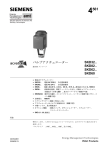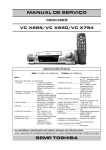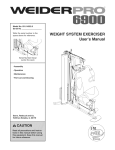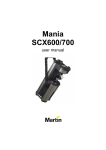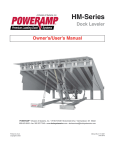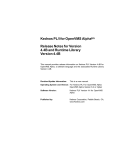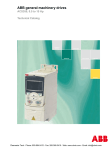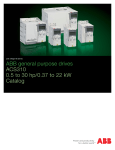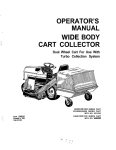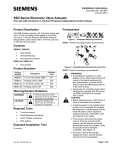Download SAX Electronic Valve Actuator
Transcript
Installation Instructions Document No. 129-561 June 11, 2014 SAX Electronic Valve Actuator Product Description The SAX Electronic Valve Actuator requires a 24 Vdc or 24 Vac, Class 2, supply signal to control a Flowrite™ 599 Series valve or a Siemens flanged, Pressure Independent Control valve with a 3/4-inch (20 mm) standard stroke. Product Numbers SAX61.03U SAX81.03U Proportional Control Actuator Three-position Control Actuator Prerequisites NOTE: Consult Technical Support if using with a TEC. WARNING: If mounting the actuator to a valve already in line, either close the shut-off valves in the piping (upstream first, then downstream) or switch off the pump to allow the differential pressure in the valve to drop. Mounting Positions Warning/Caution Notations WARNING: Personal injury or loss of life may occur if you do not follow a procedure as specified. Equipment damage or loss of data may occur if you do not follow a procedure as specified. CAUTION: CAUTION: Figure 1. Acceptable Indoor Mounting Positions. SAX Actuators can only be used for hot or chilled water, or low pressure (<15 psi) steam installations. Use on higher temperature systems will damage the actuator and lead to premature failure. Required Tools • 4 mm hex wrench, or 10 mm wrench • Flat-blade screwdriver or Phillips screwdriver to remove wiring compartment cover Expected Installation Time 30 minutes Wiring a factory-installed actuator 45 minutes Field replacement of actuator Item Number: 129-561, Rev. BA Figure 2. Acceptable Outdoor Mounting Positions with Weather Shield for NEMA 3R Protection. Page 1 of 8 Document No. 129-561 Installation Instructions June 11, 2014 A Manual adjuster (with slide switch) B Wiring knockouts C Position indication D Status indication E Housing cover F Valve stem coupling G Yoke H Bonnet connection U-bracket Installation CAUTION: Do not damage or scratch the polished surface of the valve stem. 3. Pull the valve stem to the fully extended position. Then, slide the actuator on the valve bonnet. See Figure 5. Mounting an Actuator to a Valve 1. Ensure stem connection plate in the Valve Stem Coupling is in the OPEN position. See Figure 3. Figure 5. Figure 3. 4. Completely close the bonnet connection Ubracket. See Figure 6. 2. Open the bonnet connection U-bracket. See Figure 4. Figure 4. Page 2 of 8 Figure 6. Siemens Industry, Inc. Document No. 129-561 Installation Instructions June 11, 2014 NOTE: Position the actuator to accommodate the wiring. Hold the actuator in place while tightening the actuator U-bracket bolt. 8. Secure the stem connection plate by tightening the bolt, using a 10 mm wrench (or 4 mm Allen wrench). See Figure 10. 5. Tighten the U-bracket bolt using a 10 mm wrench (or 4 mm Allen wrench) to 5 Nm (44 in-lbs) torque. See Figure 7. Figure 10. The mounting is now complete. Figure 7. 6. Rotate the manual adjuster clockwise to manually extend the actuator shaft until it covers the head of the valve stem See Figure 8. Removing the actuator from a valve 1. Loosen the stem connection plate in the Valve Stem Coupling by loosening the bolt, using a 10 mm wrench (or 4 mm Allen wrench). 2. Open the stem connection plate over the valve stem. 3. Manually retract the actuator shaft by turning the Manual Adjuster counterclockwise until it reveals the head of the valve stem. Figure 8. 7. Close the stem connection plate securely over the valve stem. See Figure 9. 4. Loosen the U-bracket using a 10 mm wrench (or 4 mm Allen wrench). 5. Completely open the bonnet connection U-bracket. 6. Push the valve stem to the fully retracted position. Then, slide the actuator off the valve bonnet. 7. Remove the actuator from the valve, being careful not to damage the valve stem. 8. Close the bonnet connection U-bracket. Figure 9. Siemens Industry, Inc. Page 3 of 8 Document No. 129-561 Installation Instructions June 11, 2014 A C Plug-in space for… − Potentiometer ASZ7.5.. (SAX81.03U only) or − Auxiliary switch ASC10.51. Plug-in space for… − Function module AZX61.1 (SAX61.03U only), or − Auxiliary switch ASC10.51 LED (SAX61.03U only) D DIP Switches (SAX61.03U only) E Calibration Slot (SAX61.03U only) F Connection Terminals B Figure 11. SAX Actuator with Cover Removed. Wiring DIP Switch Setting (SAX61.03U only) Do not use autotransformers. Use earth ground isolating step-down Class 2 power supply transformers. Switch 1: Control Signal Determine supply transformer rating by summing total VA of all actuators used. The maximum rating for a Class 2 step-down transformer is 100 VA. Select between 0 to 10 Vdc or 4 to 20 mA input signal for terminal Y (0 to 10 Vdc default). It is recommended that no more than 10 actuators are powered by one transformer. Switch 2: Flow Characteristic Do not change the flow characteristic switch. The proper flow characteristic is designed into the Flowrite 599 Series valve. Parallel Control of Actuators NOTE: SAX81.0-3U -Three-position actuators must have their own specific controller. SAX61.03U - Up to 10 actuators can be driven in parallel from a single controller output with a rating of 1 mA. Modulating actuators have an input impedance of 100KΩ. NOTE: Use either a Phillips head screwdriver or a flatblade screwdriver to remove the wiring compartment housing cover for access to the terminal block and DIP switches. Changing the default setting will modify an equal percentage valve to a linear flow characteristic. When set to default, the flow characteristic is determined by the valve body. Table 1. DIP Switch Settings. Positioning Position Signal "Y" Feedback Flow Characteristic "U" 0 to 10 Vdc 0 to 10 Vdc Default 1) ON DC 4 to 0 to 10 Vdc Modified OFF 20 mA 1) Factory setting: All DIP switches are set to OFF. Page 4 of 8 Siemens Industry, Inc. Document No. 129-561 Installation Instructions June 11, 2014 Wiring, SAX61.03U Wiring, SAX81.03U Figure 12. Connecting Terminals (SAX61.03U). G0 G Y M U Z System Neutral (SN) System Potential (SP) Positioning signal for 0 to 10 Vdc/4 to 20 mA Measuring neutral Position feedback 0 to 10 Vdc Positioning signal forced control Wiring Diagrams (SAX61.03U) A Accessories and/or 1x ASC10.51 Auxiliary Switch B 1x ASC10.51 Auxiliary Switch Figure 13. Applications. The wiring diagrams show all possible connections. The application determines which connections are used. A and B are optional auxiliary switches. Figure 14. Connecting Terminals (SAX81.03U). G Y1 Y2 System potential (SP) Positioning signal (actuator's stem extends) Positioning signal (actuator's stem retracts) Wiring Diagrams (SAX81.03U) A Accessories and/or 1x ASC10.51 Auxiliary Switch B 1x ASC10.51 Auxiliary Switch or 1 x ASZ7.5/.. Potentiometer Figure 15. Application. The wiring diagrams show all possible connections. The application determines which connections are used. Siemens Industry, Inc. Page 5 of 8 Document No. 129-561 Installation Instructions June 11, 2014 Manual Override Commissioning and Operation Manual operation Function Check and Calibration When pushing the manual adjuster down (1), it engages and the actuator can be manually operated. Mechanical Check When turning the manual adjuster in a clockwise/counterclockwise direction (2), the actuator’s stem extends/retracts. See Figure 16. Prior to making the function check, ensure that: An overload protection prevents damage to the manual adjuster. • Actuator is mechanically connected to a Siemens valve. • Actuator is in Manual Operation mode. The actuator can be operated with the help of the Manual Adjuster. Figure 16. Setting the position Upon actuation and locking the slide switch (see Figure 17), the manual adjuster remains engaged. When in this mode, do not turn the manual adjuster. Manual Adjuster Action Actuator Response Turning in clockwise direction Actuator’s stem extends Turning in counterclockwise direction Actuator’s stem retracts NOTE: Ensure that the actuator’s and valve’s stems are securely connected in all positions. If the actuator is forced to travel beyond its end positions, overload protection responds. Electrical Check Prior to making the function check, ensure that: • Actuator is mechanically connected to a Siemens valve. • Actuator is in Automatic Operation mode. Figure 17. Disengaging the setting When resetting the slide switch (see Figure 18), the manual adjuster returns to Automatic Mode. • Actuator and, if required, accessories are correctly fitted and connected. • Power is applied. Calibration (SAX61.03U Only) Calibration is required with modulating actuators, and before the function check. Calibration must be performed manually. Prior to calibrating, ensure that: • Actuator is properly connected to a valve. • Housing cover is removed. • Power is applied. Figure 18. Page 6 of 8 If required, calibration can be repeated any number of times. Siemens Industry, Inc. Document No. 129-561 Installation Instructions June 11, 2014 To initiate the calibration process insert a flat-blade screwdriver into the calibration slot to short out the two sides of the slot. See Figure 19. Table 2. LED Indication and Status. LED Indication Operating state On Automatic mode Calibration Green Blinking In manual mode On Red Blinking Figure 19. Step 1—Bridge contact. During calibration, the actuator detects the valve’s end positions and files the exact stroke in its internal memory. Calibration takes place in three phases: Off Off Calibration error Detection of foreign object No power or electronics faulty Remarks, troubleshooting Normal operation Wait until calibration is finished (then green or red light) Manual adjuster in MAN position Start calibration again Check valve / actuator Check operating voltage If the actuator does not detect the second end position within an appropriate stroke range (max. 25 mm), the first end stop will be adopted and the actuator operates with a working range of 20 mm. SAX61.03U Function Check • Actuator drives to H0 (1), retracting actuator stem. Detection of upper end position. • Actuator drives to H100 (2), extending actuator stem. Detection of lower end position. Perform the function check for modulating actuators after calibration with a point test according to the following table: Table 3. Modulating Function Check. Connection Terminals • The detected values are stored (3). Then the actuator follows the applied control signal. Observe the status indication (LED) during and after calibration. See Figures Figure 20 and Table 2. Y Y 6V 13.6 mA 5V 12 mA “Z” connected to “G” Figure 20. Step 2—Check LED. Actuator Response Position Feedback (U) Actuator’s stem extends (60%) 6V Actuator’s stem retracts (50%) 5V Actuator’s stem extends to 100% 10V “Z” connected to Actuator’s stem 0V “G0” retracts to 0% After successful completion of the function check, the actuator is ready for normal operation. SAX81.03U Function Check Perform the function check for three-position actuators according to the following table: Siemens Industry, Inc. Page 7 of 8 Document No. 129-561 Installation Instructions June 11, 2014 References Table 4. Three-Position (Floating) Function Check. Connection Terminals Actuator Response Voltage at Y1 Actuator’s stem extends Voltage at Y2 Actuator’s stem retracts Technical Instructions: Flowrite 599 Series 155-506 SAX Electronic Valve Actuator Proportional Control Flowrite 599 Series 155-507 SAX Electronic Valve Actuator 3-position (floating) Control No voltage at Y1 and Actuator’s stem maintains Y2 the position After successful completion of the function check, the actuator is ready for normal operation. Dimensions Product Numbers SAX61.03U SAX81.03U With ASK39.1 A B C C1 C2 D E ► ►► Weight lbs (kg) 9.53 (242) 10.51 (267) 4.88 (124) 6.06 (154) 5.91 (150) 11.81 (300) 2.68 (68) 7.87 (200) 3.23 (82) 3.94 (100) 3.15 (80) 3.94 (100) 3.94 (100) 7.87 (200) – – – – 4.1 (1.85) 4.6 (2.08) Figure 21. SAX Dimensions in Inches (Millimeters). Information in this publication is based on current specifications. The company reserves the right to make changes in specifications and models as design improvements are introduced. Flowrite is a registered trademark of Siemens Industry, Inc. Other product or company names mentioned herein may be the trademarks of their respective owners. © 2014 Siemens Industry, Inc. Siemens Industry, Inc. Building Technologies Division 1000 Deerfield Parkway Buffalo Grove, IL 60089 USA + 1 847-215-1000 Your feedback is important to us. If you have comments about this document, please send them to [email protected] Document No. 129-561 Printed in the USA Page 8 of 8








